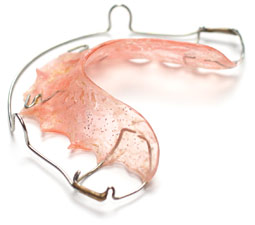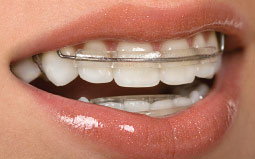The Importance of Orthodontic Retainers
Controlling tooth movement after braces
Dear Doctor,
I am 53 years old and just had my teeth straightened for the second time in my life. Why did my teeth get crooked again and why is my orthodontist telling me I need to wear retainers at my age?

Dear Garry,
Thank you for your interesting double question; as you may suspect, the topics are related.
Changes After Treatment
It used to be that we orthodontists felt that if we put the teeth in the “right” positions, they would stay there forever. Research over the past thirty years has shown that this is not true — there is no “right” position that can assure a permanent, unchanging result. In fact, most people (some studies say over 70%) will see changes to their bite and tooth alignment as they get older. This is true with or without orthodontic treatment; it does not depend upon your age at treatment and can occur for several reasons, which are not necessarily the same for each person. To explain this, we need to appreciate that there are two types of post-orthodontic treatment changes that occur.
First, when your treatment is completed, there may be an immediate tendency for your teeth to drift back to their original positions. This is because the teeth, bone and gum tissues to which they are attached have “memory.” Studies show that this tendency gradually lessens, although it may be a problem for as long as 18 months.

There is also a slower, longer lasting change that occurs over time. This is likely due to a gradual “uprighting” movement of the front teeth in the lower jaw, which can cause them to crowd as they move toward the tongue.
Although many people feel that when the wisdom teeth erupt, they are the cause of crowding of the lower front teeth, studies show that this crowding happens with or without them. The eruption of these wisdom teeth or their removal will not make a significant difference.
Although you may have had your teeth straightened in your teens or as an adult (or both), orthodontic treatment will not prevent either phenomenon just described. For most people, the only way to avoid these changes is to hold the teeth in their corrected positions indefinitely. As an aside, there are some lucky few people who do not seem to be susceptible to these changes — but there is no way to predict if you are one of them.
The only way to be sure the alignment of your teeth and your bite remains stable is to wear retainers as needed and as directed by your orthodontist.
Why Retainers?
As the name implies, retainers keep teeth from moving back into the position from which they started and, quite literally, these devices “retain” the teeth in their new position. Different orthodontists have different approaches to this phase of your treatment; most will require you to wear retainers full-time (24 hours a day) at first, and then limit the wear to nighttime (or less). After a period of time, the amount they are worn will vary according to your needs. The changes tend to be episodic. You may go for a long time with no change, and then suddenly feel your teeth are changing. This is not predictable and is unique to each person. You should remember: The only way to be sure the alignment of your teeth and your bite remains stable is to wear retainers as needed and as directed by your orthodontist.
Types of Retainers
There are several types of commonly used retainers. Some are removable and some are permanently attached behind your front teeth. The appropriate retainers for you will depend upon the specifics of your treatment, your age, and your orthodontist. There are advantages and disadvantages to each and they should be discussed.
I hope this answers your questions in a basic and understandable way. But do take the time to discuss your own case with your orthodontist so that you can be proud of your new smile and you can maintain your dental health for the years to come.




